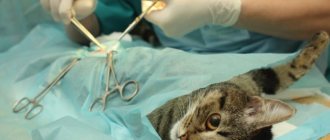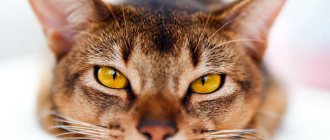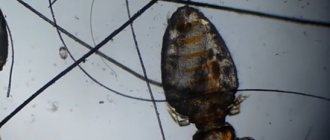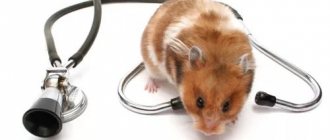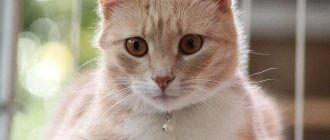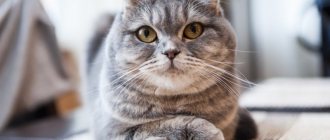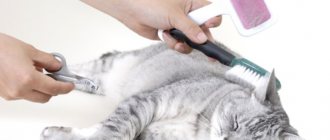Fungus in a cat is a generalized definition of diseases of the skin and internal organs caused by the activity of pathogenic microorganisms dermatomycetes (dermatophytes) on the animal’s body. Parasitizing in the upper layers of the skin, fungi cause peeling of the epidermis, dullness and hair loss, and an unpleasant odor. Lack of timely treatment leads to non-healing itchy wounds, weight loss, and a general decrease in the body's defenses. Ringworm is extremely contagious and can be transmitted to humans, therefore, if you suspect your pet has an infection, you should immediately show the animal to a specialist, identify the pathogen and begin treatment.
Causes of fungal infection in cats
Fungal diseases are one of the most common among cats, but owners are not always able to identify the infection in time and begin treatment. The Murkoshi team will help you figure out what to do if your cat has a suspected fungus and how to identify it. The risk of fungal infection in a kitten is extremely high, since the spores are always on your pet. Don’t think that cats who are never outside have no chance of getting an infection - they are also at risk.
Fungal spores spread by air; an animal can pick them up from anywhere, including from the soil left on your shoes, or simply through an open window. However, do not be afraid and lock the cat in an unventilated, sterile room. The fact is that most fungi are not dangerous for a healthy cat; they appear only in cases of serious weakening of the immune system due to another disease or stress, or continuous use of antibiotics.
Sometimes the fungus becomes only the most superficial sign of serious damage to the internal organs of the animal. It is especially worth paying attention to the condition of the cat’s claws - ordinary fungus does not affect them. If they are damaged, immediately contact a veterinarian. The same should be done if the kitten’s entire body, and not local areas, is affected by the infection.
The structure of animal skin
The skin is the largest organ of a cat, the weight of which, depending on the species, age, and nutrition of the animal, ranges from 12 to 24% of its weight. It protects internal organs from the negative effects of the external environment, regulates body temperature, acts as an organ of touch, and performs other important functions.
The skin of a cat consists of three layers:
- epidermis;
- dermis;
- subcutaneous tissue.
Epidermis
The outer layer of the skin is the epidermis, consisting of keratinized scales. It is constantly updated. The scales leave the body when they are pushed out by young cells coming from below (the process of keratinization).
The layer is durable, elastic, capable of retaining water, salts, nutrients, and preventing infection from entering the body. There are also cells associated with whiskers and hair follicles that improve the sense of touch.
It is the epidermis that is damaged more often than others. With weak immunity, he may succumb to infection and sunlight. Fleas and ticks attack him first, gnawing holes.
basement membrane
The epidermis is separated from the next layer, the dermis, by a thin basement membrane. It is involved in cell regeneration and affects their metabolism. The elasticity of the cover depends on its integrity. Some diseases of the epidermis, as well as a number of autoimmune skin diseases of cats and dogs, can damage the membrane and disrupt its functions.
Dermis
The dermis produces collagen, which maintains skin tone. Also here is:
- A network of blood vessels through which the dermis nourishes the epidermis, fur, claws, and regulates body temperature.
- Sensory and motor nerves through which the body reacts to cold, heat, itching, pain.
- Immune cells that trap infectious agents that have been able to pass through the epidermis.
Subcutaneous layer
Subcutaneous tissue is the innermost layer. It contains subcutaneous fatty tissue, which provides insulation, is a shock absorber, and a reservoir for liquids, electrolytes, and glucose.
Wool
One of the appendages of the skin is wool. Hair follicles in adult pets are complex - they have a central hair surrounded by small hairs that come from one common pore.
Their growth and condition are affected by nutrition, hormones, molting, and health. The sebaceous glands secrete a secretion that moisturizes the skin and makes the coat soft and shiny. The color of the coat can vary depending on the time of year, temperature changes, and the amount of sunlight.
Wool protects the animal's skin from physical damage and ultraviolet radiation. It helps regulate body temperature, so it's longer in winter. In summer, the coat is not only shorter, but also has fewer secondary hairs, allowing air to pass through it calmly, cooling the skin.
Cat claws
Another appendage is the claws. The cat uses them as a tool for protection, catching prey, holding meat, and climbing. By contracting the tendons, it can retract or extend them back and forth.
Symptoms of fungal diseases in cats
The types of fungi are extremely diverse, so it is difficult to identify a general list suitable for all diseases. However, there are several signs that, if detected, should be checked for infection in your furry one. First of all this:
- Scabies
- Peeling skin, dandruff
- Fading, dullness of coat
- Poor appetite
- Small rashes on the skin
- Cough
- Shaking the head, pressing the neck to the shoulders.
The fungus is most often found in kittens, as their immune system functions differently than that of adults. It also occurs among older cats, so pay special attention to their health. The hairline suffers significantly from the fungus: this is expressed in increased fragility of the wool and changes in its structure. The skin becomes flaky and itchy, which can be immediately noticed by the pet’s behavior. The cat becomes bald in places, although this depends on the type of fungus; areas of the body become red and inflamed.
Read more: How to stop hair loss in cats
Diagnostics and therapy
At the first sign of a fungal infection, you should take your animal to the veterinarian. The doctor will conduct an examination, collect information about the cat’s well-being and possible diseases, prescribe a diagnosis and recommend treatment.
If there are skin lesions, the animal may need to be examined using a Vwood lamp. The device allows you to identify cases of microsporia.
The most reliable method of identifying the pathogen is scraping the skin from the affected area, followed by culturing the fungus and determining its sensitivity to drugs. This method requires a certain time to grow flora (on average 1 to 2 weeks).
Other diagnostic methods include:
- general blood analysis;
- microscopy of wool in a 10% alkali solution for the presence of pathogen spores;
- skin biopsy;
- smears from mucous membranes;
- microscopic examination of prints of the affected areas obtained using special adhesive tape.
Symptoms and treatment are closely related. Therapy for a fungal disease depends on the type of pathogen, the degree of external and internal lesions, and the general condition of the animal. Self-medication without identifying the pathogen can cause irreparable harm to your pet.
Treatment of fungus involves:
- use of antifungal shampoos;
- applying external antimycotics (creams, ointments, powders) to the affected areas;
- taking antihistamines for severe itching;
- use of an Elizabethan collar and blanket to prevent scratching and licking of medications;
- oral or injection administration of antifungal agents.
Your pet should be treated with antibiotics strictly according to indications, adhering to the dosage. The main reason for using antibacterial drugs is the addition of a bacterial infection.
The most common types of fungus
Ringworm. If red, scaly spots appear on your pet, on which hair does not grow, contact the veterinary clinic immediately, because this disease is extremely contagious. Ringworm, caused by a microscopic fungus, is especially dangerous. The main signs of this infection are also uneven, deformed claws (as the infection affects them too). Animals that have suffered from the disease can continue to carry it for a long time, since fungal spores will remain on the cat’s fur for a long time.
Read more about this disease: What is ringworm in cats and how to deal with it
Ear fungus. Another name is Malassezia. A disease caused by a pathogen and most often seen in the ears, groin folds and armpits of pets. It should be distinguished from ear mite infestation. If you notice redness and swelling in your cat's ears, loss of wax, and an unpleasant odor, then most likely you are dealing with this type of fungus.
Aspergillosis. It affects the nasal cavity, lungs and intestines, and can cause pneumonia and inflammation of the nasopharynx. The cause of the disease is various types of mold fungi of the genus Aspergillus . Infection occurs through inhalation of conidia (spores) of pathogens. Aspergillosis is not transmitted from person to person.
Histoplasmosis. One of the most dangerous diseases, as it is treated only in the earliest stages. The main symptoms are fever, weight loss, and sometimes eye or skin irritation. Often the infection develops covertly, so if these symptoms are detected, you should immediately contact a veterinarian.
Sporotrichosis. If you notice that hair is falling out on your pet's face, tail or back, then you may be dealing with a fungal disease in cats called sporotrichosis. It is necessary to begin treatment immediately, because this disease can affect internal organs, including the liver and lungs. Do not self-medicate under any circumstances and contact a specialist, otherwise your cat may only get worse!
Fungal diseases of the eyes. Sometimes spores get into the eyes of animals, and then it becomes possible for the kitten to develop fungus right in this organ. Swelling of the eyelids, lacrimation and redness are some of the signs at the early stage of the disease, and if detected, treatment should be started immediately. At an advanced stage of development of the fungus, purulent discharge, loss of eyelashes and hair around the eyes may begin.
Precautionary measures: How to avoid getting infected
The disease is anthropozoonotic – that is, transmitted from animals to humans and vice versa. But we hasten to reassure you a little: the risk of infection for an adult healthy person is negligible.
Children and the elderly, as well as those weakened by other diseases, are most susceptible to infection with the fungus. Therefore, if there are small children, old people or seriously ill people in your house, then of course the most optimal solution would be to isolate the sick animal in another room until it has fully recovered.
If the inhabitants of your apartment are all adults and healthy people, then it will be enough to treat the cat’s skin with ointments, wearing gloves and a mask, carry out daily wet cleaning using antiseptics, iron the fabrics with a hot iron, and wash your hands.
Watch the video: Veterinarian advice: skin diseases in cats and their diagnosis
Treatment of fungus in cats
You can treat cats at home only with the permission of specialists, because your pet’s health directly depends on any of your actions. If you are allowed to care for your furry one yourself, then here are the most common methods of treatment:
- use of antifungal shampoos;
- the use of disinfecting and soothing antifungal agents on the animal’s skin (clotrimazole, tar ointment, econazole, Sanoderm and others);
- injections of antifungal medications (strictly according to a doctor's prescription!).
Malassezia pathogen
The yeast-like fungus Malassezia pachydermatis is an opportunistic microorganism that is constantly present on the skin of healthy cats, but does not cause disease. Increased proliferation of fungi and the appearance of the clinical picture of malassezia occurs with a sharp decrease in the body's resistance, provoked by:
- poor diet;
- exhaustion;
- injuries or large blood losses;
- infectious and invasive pathologies;
- stress;
- allergic reactions;
- poisoning;
- scratches, burns, cuts and other skin damage.
Prevention of fungal disease in cats
Of course, it is impossible to completely protect your cat from fungal disease, but the most effective remedy is to maintain the furry cat’s immunity at the required level. What does this include? Of course, proper keeping of a pet in a clean apartment will take first place, since the environment of the house directly affects the health of its inhabitants. Temperature and humidity must be maintained within normal limits to prevent the creation of favorable conditions for the spread of infection.
The second is a balanced, proper diet for the cat. The prevention of not only fungi, but also many other diseases depends on this factor. Monitor the balance of vitamins in your pet’s diet and adjust it if necessary. We recommend super premium and holistic food, as they contain everything you need. This kind of nutrition can be called balanced. By the way, we only use these feeds.
Read about proper nutrition: What food to feed your cat
And of course, it is necessary to contact a veterinarian if you detect the slightest symptoms of disturbances in the functioning of the animal’s body. Remember that fungus in cats can be an extremely dangerous disease. The Murkoshi team strongly advises against self-medication, because it can sometimes lead to consequences even worse than ignoring the infection.
Recommendations
Animals suffering from malasseziasis are advised to periodically bathe with a special shampoo. You should monitor the folds of the skin, the external auditory canal, the interdigital areas, and if brown plaque appears, begin local treatments, since local treatment carried out on time can minimize the intake of tablets and medications for the cat.
You should not keep the animal constantly in a humid environment; you need to monitor its diet (if a food allergy is diagnosed). To protect your cat from fungus, you need to regularly treat the animal against fleas and other ectoparasites.
(c) Veterinary center for the treatment and rehabilitation of animals “Zoostatus”. Varshavskoe highway, 125 building 1. tel. 8 (499) 372-27-37
Caring for a sick cat
Your veterinarian will need to monitor liver enzymes monthly while your cat is taking antifungal medications.
Improvement in clinical signs, resolution of lesions, overall improvement in well-being, and return of appetite will determine your cat's response to treatment.
The estimated duration of treatment is from three months to one year; Patients with central nervous system disease may require lifelong maintenance treatment.
Cats that are also infected with feline leukemia virus (FeLV) or feline immunodeficiency virus (FIV) will have a worse prognosis for recovery.
Your veterinarian will measure the presence of Cryptococcus antigens every two months and for six months after completion of treatment (or until the antigen is no longer detectable).
If your cat is able to maintain low titers—the amount of medication or antibodies found in the blood—for several months after all signs of illness have disappeared, treatment will continue for at least three months.
If symptoms suddenly increase after treatment, therapy is resumed.
